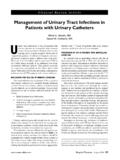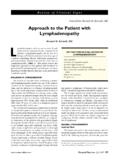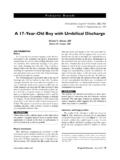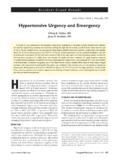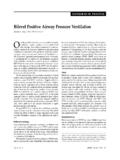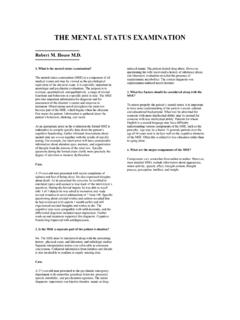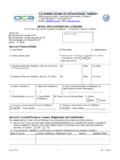Transcription of Neuroleptic Malignant Syndrome: A Brief Review
1 Clinical Review Article Neuroleptic Malignant syndrome : A Brief Review Thomas N. Bottoni, MD. euroleptic Malignant syndrome (NMS) is a sons age 20 to 40 years and involves patients with schizo- N rare, idiosyncratic disorder. As its name implies, NMS is a potentially lethal process related to the use of Neuroleptic agents (eg, butyrophe- nones, phenothiazines, thioxanthenes) that produce dopaminergic blockade. NMS may occur in any patient phrenia taking Neuroleptic agents as treatment of psy- chosis; the second and lesser peak occurs in patients older than 70 years who are on levodopa and/or neu- roleptic drugs to control behavioral symptoms (espe- cially agitation) of dementia or ,5.
2 Taking a Neuroleptic drug, regardless of the duration of The mortality rate from NMS has been declining in use. The disorder is characterized by several cardinal fea- recent years. Before 1984, the mortality rate was nearly tures, including autonomic dysfunction, altered mental 40%.6 Since then, the mortality rate has decreased to status , muscular rigidity, and hyperthermia. , which is still a quite significant The Although relatively uncommon, NMS carries a sig- decline in mortality rate has largely occurred because nificant mortality rate, which mandates early recogni- of earlier physician recognition and treatment of the tion and intervention; the disorder can present quite a disorder, in addition to newer and better critical care clinical challenge in treating agitated patients who therapeutic modalities.
3 Have both medical and psychiatric illnesses. NMS is of particular interest to emergency physicians because ETIOLOGY AND PATHOPHYSIOLOGY. of its acute onset, its severity, and the fact that its mor- NMS is believed to result from dopaminergic block- tality can be substantially reduced through prompt ade or depletion in the central nervous system. Neuro- recognition and treatment. The disorder shares many leptic drugs block dopamine receptors in various areas clinical features with other hyperpyrexic disorders, in- of the central nervous system including the hypothal- cluding Malignant hyperthermia, serotonin syndrome , amus, the corpus striatum, the basal ganglia, and spinal lethal catatonia, environmental heat disorders, and areas with wide-ranging effects.
4 Sudden and pro- infectious diseases. found central dopaminergic blockade is the most This article will present an overview of NMS through favored hypothesis for the pathogenesis of This discussion of the etiologic and pathophysiologic mecha- hypothesis is supported by animal model nisms that underlie the disorder. Special emphasis will Theoretically, central dopaminergic blockade ex- be placed on the early recognition of NMS, including plains the clinical tetrad of symptoms seen in NMS. its atypical presentations, and the therapeutic measures Muscle contraction and rigidity occur when dopamine available to the practicing clinician to avert some of the effects are blocked in the corpus striatum.
5 Subsequent unfortunate complications of the disorder. muscle contraction generates a tremendous amount of heat energy peripherally and results in pyrexia. Pyrexia HISTORY AND EPIDEMIOLOGY also occurs secondary to impaired heat dissipation Neuroleptic medications were first introduced in when dopamine receptors are blocked in the thermo- 1954, and Delay and Deniker first described NMS in regulatory centers of the preoptic nuclei of the anteri- The reported incidence of NMS ranges from or hypothalamus. mental status changes may be caused to 3% of patients taking Neuroleptic It by dopamine receptor blockade in the nigrostriatal occurs equally in men and women and has been report- and mesocortical systems.
6 Finally, dopamine receptor ed in patients as young as 3 years and as old as 80 years. Most cases, however, occur in young and middle-aged adults, among whom the use of Neuroleptic medica- Dr. Bottoni is a Lieutenant Commander, Medical Corps, US Navy Reserves, tions is There is an asymmetric bimodal distri- and a Staff Emergency Physician and Educational Coordinator, Naval bution of cases: the first and greater peak occurs in per- Medical Center, Portsmouth, VA. 58 Hospital Physician March 2002 Bottoni : Neuroleptic Malignant syndrome : pp.
7 58 63. blockade at the level of the spinal cord may be respon- Table 1. Drugs That Can Cause Neuroleptic Malignant sible for the autonomic disturbances seen with ,7 syndrome Additional clinical support for the dopaminergic depletion theory of NMS is provided by the improve- Neuroleptic drugs ment of patients with NMS after treatment with dop- Butyrophenones aminergic agonists such as bromocriptine and amanta- Phenothiazines dine. Furthermore, NMS resulting from temporary Thioxanthenes cessation of dopamine therapy in patients with Park- inson's disease may be readily reversed with a return to Other dopamine antagonists dopamine agonist ,8 Hydroxyzine NMS can develop with either initiation of neurolep- Reglan tic therapy or a change in drug dosage.
8 The risk for Reserpine NMS can be increased by initiation of a Neuroleptic Nonneuroleptic drugs therapy at high drug dosages, by rapid upward titration, by a change to higher potency Neuroleptic agents, or by Tricyclic antidepressants the use of long-acting depot The onset Amitriptyline of NMS is not related to the duration of Neuroleptic Amoxapine exposure or to toxic overdoses. It can occur anywhere Desipramine from a few hours to days after initiation of therapy or Maprotiline even several years after being on a stable dosage regi- Monoamine oxidase inhibitors Drug levels are often found to be therapeutic in most cases of ,10 More than 25 pharmacologic Phenelzine agents have been implicated as triggers for NMS, most Tranylcypromine commonly butyrophenones, phenothiazines, and thiox- Benzodiazepines anthenes.
9 Haloperidol and fluphenazine have been the Diazepam most commonly cited drugs, probably because of their Lorazepam widespread use and higher potency. Other agents . Anticonvulsants including tricyclic antidepressants, monoamine oxidase inhibitors, and lithium have also been reported to Carbamazepine cause NMS, perhaps through synergistic interactions or Phenytoin as yet undefined ,10 Table 1 lists drugs that Dopaminergic medications temporarily withdrawn in patients have been cited as common triggers of NMS. with Parkinson's disease Some patients seem to have a predilection for NMS Amantadine when treated with any dopamine antagonist.
10 Others Bromocriptine develop the disorder only when treated with specific Levodopa dopamine antagonists. In some cases, reinstitution of Neuroleptic therapy with the same drug following full Lithium recovery from NMS has been undertaken cautiously Data from Chan et al,10 Heyland and Sauve,11 Koehler and Mirandolle,12. without further ill ,10,14,15 The likelihood that and someone will develop NMS thus seems to be more dependent upon his or her physiologic state at the time of administration of the Neuroleptic ,10,16,17 its clinical features may not always be appreciated and Additional risk factors for NMS include high ambient may initially lead to diagnostic delay and confusion with temperatures and humidity, dehydration, concomitant other, more common ,10,18 Table 2 lists alter- illness, AIDS-related dementia, head trauma.



